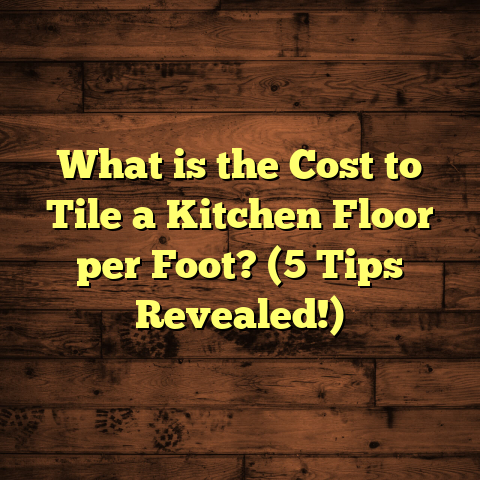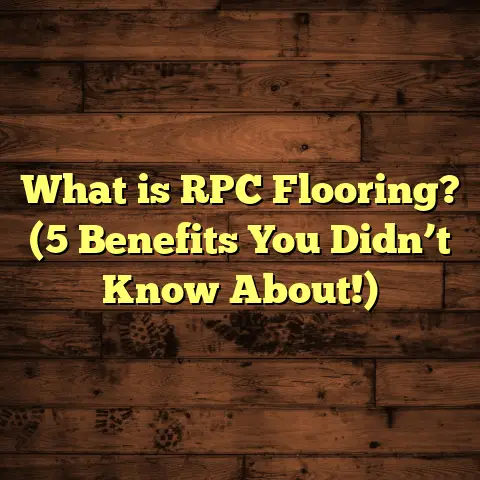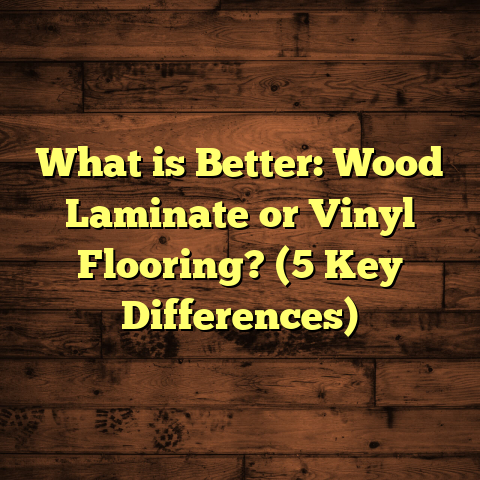What is a Wood Floor Worth? (5 Factors Impacting Value)
Uniqueness is something I always appreciate when walking
into a home with wood floors. Each plank tells a story —
the grain, the color, the finish — all of it adds character
no tile or carpet can ever match. Over the years, I’ve come
to realize a wood floor isn’t just about appearance; it’s a
serious part of a home’s value.
So, what exactly makes a wood floor worth something? And how
do you figure out what yours might be worth if you want to sell,
or just understand how your investment is holding up?
I want to take you through what I’ve learned from both my own
flooring projects and from working with homeowners and contractors.
There are many factors that influence the value of a wood floor, and
they’re not always obvious.
What is a Wood Floor Worth?
When I say “what is a wood floor worth,” I’m talking about more than
just the cost of buying and installing it. It’s about the total value
that wood flooring adds to your home — financially, functionally, and
emotionally.
Financially, it means how much your home’s market price might increase.
Functionally, it means how much better your daily living experience becomes
because of the floor’s durability and comfort. Emotionally, it’s the warmth
and personality wood brings to your space — something that synthetic materials
struggle to replicate.
You might wonder: Is a wood floor worth the extra money compared to other options?
Is it better to go for cheaper laminate or luxury vinyl planks? Or should you invest
in high-end exotic hardwoods? How much does installation quality really matter?
I’ve been through these questions myself in various projects and have helped many
clients make decisions that fit their budgets, tastes, and goals.
The Many Faces of Wood Flooring Value
Let me start by sharing a story. A few years ago, I was called in to consult on a property
that had just gone on the market. The owners had recently installed engineered hardwood floors
throughout their living spaces but were frustrated because they weren’t seeing the price bump
they expected.
After inspecting the floors and learning about their installation process, I realized two things:
- The flooring was mid-tier quality and poorly installed with visible gaps between planks.
- The local market didn’t highly value engineered wood compared to traditional solid hardwood.
This experience made me realize that wood floor value isn’t just about slapping down some planks and calling it done.
It depends on multiple intertwined factors — some related to the wood itself, others tied to craftsmanship and market trends.
5 Factors Impacting the Value of Your Wood Floor
I like to break things down into five main areas that really shape what a wood floor is worth:
1. Type and Quality of Wood
Wood species matters more than most people think. Each type of hardwood has its own hardness rating (measured by the Janka scale), grain pattern, color variation, and wear characteristics.
For example:
- Oak is classic and widely used in American homes. It’s durable (about 1290 on the Janka scale) and has a grain that many people find appealing without being too flashy. It’s often considered a safe investment because buyers recognize and appreciate it.
- Maple is harder (1450 Janka) but has a less pronounced grain pattern. It’s great if you want a cleaner look but might not have as much “character” as oak.
- Walnut is softer (1010 Janka) but prized for its rich dark brown hues and elegant grain. It tends to cost more because of its luxurious look.
- Exotic woods like Brazilian cherry or teak can have very high Janka ratings (2000+), making them extremely durable. But they come with a higher price tag and sometimes require special maintenance.
On one of my favorite projects, I installed hickory flooring for a client who wanted something different from the usual oak or maple. Hickory is very tough — around 1820 on the Janka scale — and has dramatic color variations from creamy white to deep brown. The floor instantly became a conversation piece in their home.
According to data from the National Wood Flooring Association (NWFA), solid hardwood floors can increase home resale value by roughly 2-5%. That means on a $400,000 home, you could see an increase between $8,000 to $20,000 just for having quality hardwood floors.
There’s also engineered hardwood — layers of real wood veneer over plywood or fiberboard — which gives you the look of hardwood with better moisture resistance and often at a lower cost. But in some markets, buyers see engineered hardwood as less valuable than solid hardwood.
2. Installation Quality
This is where craftsmanship makes or breaks your investment. You could buy the finest wood in the world, but if it’s installed poorly, your floors won’t last or look good — which eats away at their value.
Here are some common issues I’ve seen from bad installations:
- Gaps between planks due to improper acclimation or subfloor preparation.
- Uneven surfaces causing squeaks or an uneven walking experience.
- Poorly finished edges or incorrectly nailed boards leading to damage over time.
One time, I helped a family fix an installation nightmare where their walnut floor was laid over a damp concrete slab without a proper vapor barrier. Within six months, many boards cupped and warped due to moisture exposure.
Good installers know how to check moisture levels in both subfloor and wood before installation, use proper adhesives or nails based on flooring type, and allow wood time to acclimate indoors.
If you’re planning an installation, don’t skimp on labor costs just because material prices are high. A skilled installer can save you money by preventing costly repairs down the line.
3. Floor Age and Condition
New floors obviously have value because they look fresh and often come with warranties. But older floors can sometimes add more character — especially if they’re original to historic homes or have been well maintained.
I once restored pine floors in a 1920s bungalow. They had deep scratches, faded finish, and some minor warping but brought so much warmth after sanding and refinishing that the home’s selling price jumped by about 7% in our local market.
Many real estate agents tell me that buyers love original hardwoods because they represent authenticity and craftsmanship that mass-produced floors can’t match.
That said, age also means you need to consider wear patterns like scratches, dents, discoloration, or water damage that reduce value if ignored.
4. Finish Type and Maintenance
The finish protects your wood floor while also influencing its look.
Some finishes I’ve worked with include:
- Oil-based polyurethane: Offers a warm amber glow but takes longer to dry and can yellow over time.
- Water-based finishes: Clearer look with faster drying but less build-up of protective layers.
- Hardwax oils: Penetrate wood and create a natural feel but require regular maintenance.
- Wax finishes: Traditional look but prone to scratching and require polishing.
Maintenance plays an underrated role here. Floors that look clean and cared for hold their value better than neglected ones.
I remember advising a client with kids and dogs to avoid glossy finishes because scratches showed too easily. Instead, we went with matte water-based polyurethane that hid wear better while still protecting well.
Regular cleaning with appropriate products (no harsh chemicals) plus minor touch-ups will keep floors looking great for years.
5. Market Trends and Geographic Location
Value also depends heavily on where you live and what local buyers expect.
In cities like New York or San Francisco, hardwood floors are often seen as essential for upscale apartments — so they add significant value. In suburban or rural markets where carpet dominates for warmth or cost reasons, hardwood might not boost prices as much but still attracts certain buyers.
I worked on homes in Florida where moisture issues meant tile was more common in living areas than wood flooring; buyers expected that because of humidity.
Real estate data shows homes with hardwood floors tend to sell faster — sometimes 10-15% quicker — than comparable homes without them in many markets.
Digging Deeper: Comparing Different Flooring Options I’ve Tried
Because I install many types of floors, I’ve gotten first-hand experience comparing how each impacts home value.
Hardwood vs Laminate
Laminate floors mimic wood visually but are made of fiberboard with a photographic layer topped by clear plastic coating.
While laminate is affordable ($1-$3 per sq ft installed) compared to hardwood ($6-$12+), it doesn’t add as much resale value.
Buyers tend to prefer real wood for its feel and longevity; laminate can’t be refinished once worn out.
My advice: laminate works well for tight budgets or renters but won’t boost your home’s price like real hardwood.
Engineered Hardwood vs Solid Hardwood
Engineered hardwood is more dimensionally stable due to plywood backing layers; it resists moisture better making it ideal for basements or kitchens.
It’s usually less expensive upfront but may carry slightly less resale premium depending on market preferences.
In my own basement renovation, I chose engineered hardwood because it wouldn’t warp with higher humidity levels — still looked authentic but avoided issues solid wood might have had there.
Vinyl Plank Flooring
Luxury vinyl planks have come a long way visually and can be waterproof — great for bathrooms or basements.
However, vinyl rarely adds value comparable to wood since many buyers see it as a budget option.
Still, it can be smart for areas prone to moisture damage where hardwood risks failing.
Tile vs Wood in Living Spaces
Tile is incredibly durable but cold underfoot and less inviting visually than wood in living areas.
In kitchens or bathrooms, tile makes sense; in living rooms or bedrooms, wood generally has greater appeal and higher perceived value.
How FloorTally Helped Me Manage Costs
One challenge I often face is balancing quality with budget when planning flooring projects.
Material prices fluctuate seasonally; labor rates vary by region; plus waste factors add complexity when ordering materials.
FloorTally became my secret weapon for estimating costs accurately without guesswork.
By entering room sizes, choosing materials including species and finishes, I get detailed cost breakdowns that include labor estimates based on local rates.
It even factors waste percentages so I know how much extra material to buy without overordering — which saves money and reduces leftover scrap.
This clarity helps me plan projects effectively with clients so we avoid surprises mid-job or budget overruns later on.
Personal Lessons from My Flooring Journeys
I want to share some personal insights from the flooring jobs I’ve done over the years:
- Don’t rush installation: Allow wood time to acclimate indoors before laying it down — rushing leads to warping or gaps later.
- Choose finishes based on lifestyle: Families with pets should avoid glossy finishes that show scratches easily.
- Maintain your floors: Regular cleaning with recommended products prevents buildup that damages finishes.
- Buy from reputable suppliers: Cheaper wood may save money upfront but often lacks consistency in quality.
- Think long term: Good flooring is an investment; spend wisely on materials and installation because you’ll live with it for years.
- Local market matters: What adds value in one area might be neutral elsewhere — talk to local real estate pros before major decisions.
Data Points & Research You May Find Useful
- According to Remodeling Magazine’s Cost vs Value Report 2023: Hardwood flooring replacement recoups about 70-80% of its cost at resale.
- A study from Zillow found homes with hardwood floors sell faster by approximately 6 days on average.
- National Wood Flooring Association reports demand for eco-friendly finishes increased by 25% in recent years.
- Research shows engineered hardwood sales have grown steadily due to improved technology making them more durable.
- Real estate agents often advise adding hardwood increases buyer interest by nearly 30%.
FAQs Based on My Experience
Q: How do I choose between solid hardwood and engineered hardwood?
A: Consider moisture levels where you’ll install it; solid hardwood suits dry areas; engineered works better in basements/kitchens due to stability. Also think about budget — engineered usually costs less upfront but may have slightly lower resale impact depending on market.
Q: Can I refinish engineered hardwood?
A: Only if it has a thick enough top veneer (usually 3mm+). Some cheaper types only allow one sanding; solid hardwood can be refinished multiple times over decades.
Q: How often should I refinish my wood floors?
A: Depends on wear but usually every 7-10 years for residential homes if properly maintained.
Q: What’s the best finish for pet owners?
A: Matte water-based polyurethane is great; hides scratches better than glossy finishes while still protecting well.
Q: Will installing hardwood add value if my home has carpet now?
A: Usually yes; many buyers prefer hardwood over carpet especially in living/dining areas — expect roughly 2-5% increase in home value based on studies mentioned earlier.
Final Thoughts: Is Your Wood Floor Worth It?
I hope walking you through these factors has given you a clearer picture of what affects wood floor value.
If you’re considering new floors or selling your home soon, think carefully about species choice, installation quality, finish type, maintenance plans, and your local market trends.
Investing thoughtfully upfront pays off by making your home more attractive to buyers and more enjoyable daily.
If you want help estimating costs or figuring out options tailored for your project, tools like FloorTally make those decisions easier by bringing all pricing info into one place quickly.
And if you want some advice specific to your home or neighborhood trends, feel free to reach out anytime — flooring has been my passion for years, and I love helping people get the most from their homes!





